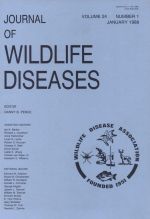Nine species of helminths, all nematodes, were recovered from the viscera of 48 feral swine (Sus scrofa) from Cumberland Island, Georgia. Both the overdispersed frequency distributions and the abundances of the four common species of helminths (Stephanurus dentatus, Metastrongylus apri, M. pudendotectus and Gongylonema pulchrum) did not vary significantly across the main and interactive effects of host sex and/or seasons. Whether or not the present low population densities of feral swine on Cumberland Island has influenced the pattern of fluctuations in abundances of helminth species across seasons as often observed in helminth communities from other hosts was not resolved. The apparent recent decline in prevalences and abundances, and the loss of certain species from the helminth communities of feral swine on the island may be explained partially by the decreasing transmission potentials of direct life cycle species caused by a recent marked reduction of numbers of individuals in the host population. Conversely, the apparent increased prevalence and abundance of three species of helminths (S. dentatus, M. apri and M. pudendotectus) may be related to their common utilization of earthworms as paratenic or intermediate hosts. Gongylonema pulchrum was the only helminth in which abundances seemed to remain unchanged. This was the only species that was not strictly host specific to feral swine. We found no evidence that helminth infections were responsible for morbidity or mortality in this feral swine population.
How to translate text using browser tools
1 January 1988
VISCERAL HELMINTH COMMUNITIES OF AN INSULAR POPULATION OF FERAL SWINE
Danny B. Pence,
Robert J. Warren,
Charles R. Ford

Journal of Wildlife Diseases
Vol. 24 • No. 1
January 1988
Vol. 24 • No. 1
January 1988
distribution patterns
ecology
feral swine
helminth communities
host sex
nematodes
overdispersion




